The Stgw 57 was Switzerland’s first standard-issue selfloading service rifle. The Swiss experimented with designs for ten or twelve years (including the AK52) before adapting the model 57 in, appropriately, 1957. The design is based on the German roller-locking system, and uses a delayed blowback system like the StG45 rather than a truly locked mechanism.
The Swiss originally developed the rifle for the 7.5×55 GP11 cartridge, and designated the rifle Stgw57 for military use and SIG 510 for export sales. These rifles used a curved 24-round box magazine. Several other variants were also made for export, primarily the SIG 510-4 and AMT (American Match Target). Both of these was chambered for 7.62 NATO and used 20-round straight magazines. The American rifles were semi-auto only, and some were imported in the original 7.5 Swiss caliber (these were designated PE-57). Only about 4000 AMTs were imported into the US, and they remain a rare rifle in the country.
The Stgw57 is a very finely machined rifle, and includes several notable features. As with all roller-delayed designs, the roller recesses in the receiver will eventually wear down, and begin to increase the cartridge headspace. The German rifles (HK91 etc) accept this as the functional service life of the rifle, but the SIG has interchangeable locking recesses, so they can be replaced when worn. The sights on the export guns are a basic sliding aperture, but the Swiss issue guns use a micrometer type folding rear sight very reminiscent of the German FG42.
The Stgw57 was the primary Swiss infantry rifle until the 1980s, when the SIG 550 was adopted to replace it. The Stgw57 was also adopted by the Bolivian and Chilean armies. A version in 7.62x39mm (the 510-3) was developed for trials in Finland, but ultimately not put into production.
Videos
Manuals
Photos
Sig Stgw 57 and AMT photos (click here to download high resolution copies):
Resources:
BiggerHammer.net has a resource section on the SIG AMT/510 with good information and a couple reprinted articles.

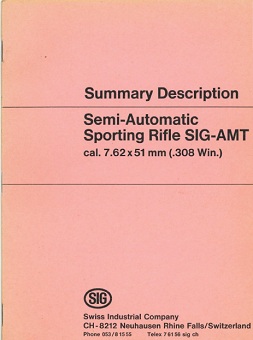
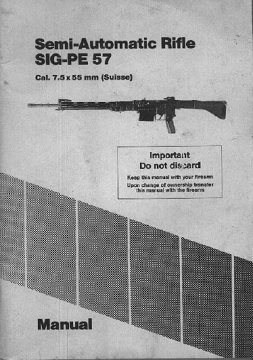

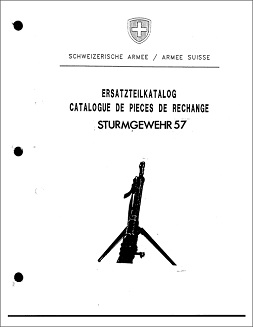


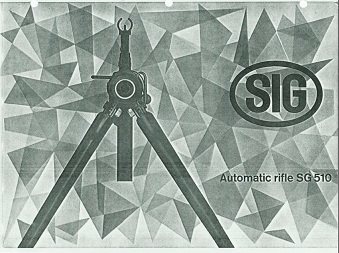
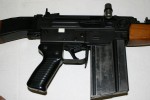
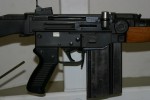

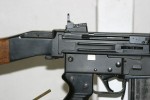





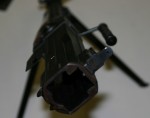

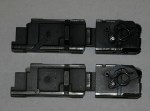


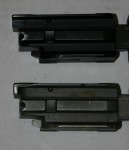


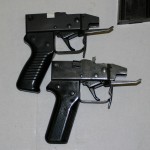
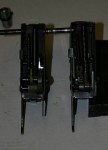

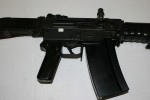
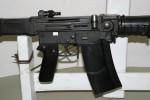
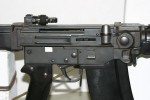
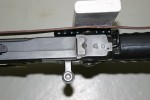



As noted, a number of these SIG rifles in 7.62x51mm were bought by Chile and Bolivia. In a recent Icíar Bollaín Spanish film that takes place in Bolivia during the recent “water war,” _Even the Rain/ Tambien la lluvia_ there are scenes of Bolivian troops clubbing demonstrators with the butt-stocks of old SIG AMT rifles.
I like watching old films of the Chilean Coup of 1973 where soldiers used the rifles to round up communist subversives into the national soccer stadium before disposing of them FOR GOOD.
Very informative! I very much appreciate the german machine guns, quality, reliability and especially how SIG has kept up on little cosmetic similarities on newer rifles as the did on the old(pistol grip, slotted heat shield, and some circle sights.
German Rifle ? Greetings from Switzerland.
I actually got to hold a PE57 in my hands back in the 80s. From what I remember it LOOKED very cool but was quite heavy. I wouldn’t want to lug one around for any distance. Kinda strange that a country that always declares neutrality and never gets involved (directly) in European problems puts so much emphasis on weapons. Not like anyone ever makes plans to invade Switzerland.
Kinda strange that a country that always declares neutrality and never gets involved (directly) in European problems puts so much emphasis on weapons. Not like anyone ever makes plans to invade Switzerland.
if you have German as a neighbor you would change your opinion.
peter
switzerlnd/zuerich
american legion member
Peter
How available are stgw 57 parts? Shooter50bmg@yahoo.com
You can buy a PE-57 for about 400-500 bucks here in Switzerland. I don’t know about parts, but from that price I guess that won’t be a problem. There are lots of them around.
Hi.
I have an AMT and would like to have it approach the look of The the much cooler P57.
Could you suggest a gun store in the Confederation Helvetique which would have available the plastic forearm, buttstock, and pistol grip? Would really appreciate your help.
I can confirm this opinion. Matt from Poland.
Good fences AND good weapons make for good neighbors !
So the rearward motion generated by firing acts upon the “bolt carrier” to the rear of the bolt, which compresses against the recoil spring to it’s rear while the forward part i.e. The bolt is locked via the rollers into the recesses in the receiver, the movement of the carrier unlocks the bolt by allowing the rollers in the bolt to compress via it’s shaped surfaces retracting.
The Hk versions have a bar attached or formed from the bolt carrier though don’t they which also gives it mass and acts as either a guide rod for the recoil spring or as a point of contact for the forward mounted non reciprocating cocking handle assembly, so given the lack of this “bar” that perhaps explains the increased bulk of the Swiss guns bolt/carrier in relation to the German ones presumably they weigh similar in regards the resistance of there respective recoil springs in the same calibre.
This “loose weight” i.e. The bolt carrier provides the “umph” when in set into a rearward motion by the recoil forces generated upon firing.
I really like this gun, that trigger is fab amongst other things…
Good job I watched the Gerat videos and this or I would possibly never have been struck by the notion in my amateurish attempts to design firearms on paper that said forces generated by firing could actually unlock the bolt by themselves if so desired by the appropriate design seems obvious almost now after numerous viewings ha.
The Stgw57 presumably utilises a fluted chamber also, perhaps four flat rods set to overlap each others ends in a diamond shape:
/\
\/ could be pinned together so they could swivel in the middle and then to each other at either end to a bolt section at the front “top of the diamond” and a weight to it’s rear in the same manner so as to permit movement of the rods whilst attached to the peices aforementioned.
The pins which would hold the four rods together in the middle “of the diamond” could be fitted with rollers at either end giving four vertical rollers in a H type shape if it’s central – part is the rods laying horizontally, these rollers could fit into recesses resembling a [] shape.
A recoil spring would sit behind the weight in a tubular receiver, and the rollers would sit flush behind the upper and lower protrusions of the [ shape. Now upon firing, via a offset hammer/pin arrangement as per the video. Recoil would act upon the weight compressing the spring and retracting the rods inwards via the swivel pins, the rollers would now fit into the gap between the recesses and the entire diamond piece would move rearward in it’s contracted form kept in place via the shape of the recesses sides.
That bounce effect generated by the bolt coming to an abrupt halt when it comes into contact with the barrel causing the carrier behind to “judder” rearwards, is replicated by recoil on firing initially in semi auto isn’t it i.e. when the bolt is fully forward. That’s how it is a delayed blowback, because the carrier isn’t locked only pushed forward under spring pressure when the spring is compressed the carrier allows the rollers to disengage from the recesses and the rearward motion generated by firing pushes the carrier back.
So if the distance was extended, between the carrier and the bolt perhaps the delay between the rollers becoming disengaged from the recesses would be lengthened sufficiently to remove the need for a fluted chamber.
How many of these rifles were sold to chili?
How many PE 57’s were imported to the US? Thanks
Today i shot the Stgw 57! it was a great deal because of its accuracy. I was astonished how exactly it works. Better than any Stgw. 90 or even Stgw. G 36. It is a
powerful mixture between a Machine gun 42, a Stgw.44 and a Fallschirmjäger Gewehr 42. All in one. One in all.
To me a very beautiful weapon and what a pity that it is not longer in use.
It is interesting to note that Beretta manufactured around 30,000 SIG 510-4 7.62mm NATO rifles for the Chilean contract as SIG was not allowed too under strict export regulations in the early 60’s. Beretta then went on to experiment with the design and modified it somewhat into the prototype BL-62 rifle which had a unified butt/recoil/trigger assembly instead of the two piece original design. They only made a few rifles, probably less than 50 from the prototypes I have handled at the Beretta factory….
Molto interessane , è possibile avere o dare maggiori informazioni?
As a Fusilier I did my military service in Switzerland in 1985, the SIG 57 was our standard assault rifle. As a member of my platoon l also carried sniper sights. It is true that the rifle was heavy however you quickly got used to this. We all carried two rifle grenades as well, these slid on the top of the barel and could either be fired in the prone position (never shouldering the butt due to excessive recoil), or fired upward with the butt resting on the ground. This way of firing gave the weapon a type of mortar use, distance and angle of fire was measured by extending one of the bi-pod rests which was marked with numbers, you would dangle your swiss army penknife from a string attached to the bayonet fixing point and angle the rifle accordingly so that the string would appeared next to the number required to hit the target. The Swiss army SIG 57 also has a “winter” trigger, this was a larger and longer fold away trigger that allowed the soldier to fire whilst wearing winter gloves.l also specialised in anti-tank and carried a Raketenrohr “bazooka”, carrying this, the two rockets it fired, the SIG 57 and its two rifle grenades sure made our mountain marches extremely athletic!
I believe that the rifle’s weight is largely due to its quality material and solid build, this weight is also what goes towards its accuracy at long distance as the recoil does not move the sight far off target. A truly versatile piece of equipment.
PS. The SIG 57 also stars in the 007 film “On Her Majesty’s Secret Service”. As this was filmed primarily in the Swiss Alps, the armed muscle belonging to the bad guy under Spectre all carried this weapon.
Its a bit odd that we in the US fail to see that the Swiss don’t design weapons like we do-to be used in a wide range of environments like our army finds itself in. They design primarily for use in their own country and their own requirements. One of the ideas behind the Stgw 57 was to replace both the rifle (K31) and the light machinegun (LMG 25) which it appears to have done quite well. So when you say the 57 is heavy you should consider humping an LMG25 around.
The numbers given at the beginning aren’t quite correct. There were approximately 3000 of the SIG AMT rifles imported into the US from the mid 60’s til the present. This is a number that doesn’t include private imports which were legal and proper. I know a few guys who bought them through the PX system and did private imports. There were more AMTs made but not imported to the US. I know of people in Germany,Italy and Switzerland who have them.
As for the PE 57 there were about 4000 made overall compared to over 800,000 Stgw 57. All of the PE57s are marked on the receiver PE57 and have a serial number of 4 digits or less. The Stgw57 is marked with a serial number beginning with the letter A and no model marked. Basic point here is that if you see a serial with more than 4 digits its not a real PE. Just because its a 57 doesn’t mean its a PE. There are a lot more Stgw’s than PEs so quit calling them all PE57.
Its a wild ass guess that somewhere short of 2000 of them were imported into the US. They weren’t all that popular due to cost and the fact that they fired a round not readily available here in the states. They are in demand now and bring $7000 plus. The last imports were the neutered DSA imports with the muzzle brake turned off, the bayo lug left out and a really bad looking thumbhole stock installed.
Squeeze a fresh peach pit between your fingers and watch it spit out and fly across the room. This is how the roller locking system works. The rollers are pressed inward by the locking surfaces in the receiver or trunnion. Pressing inward on an angled locking piece forces the locking piece backwards and by doing so pushes the carrier backwards. Inertia of the carrier and gas pressure on the case pushes(pulls) the bolt back with enough velocity to operate the system when the rollers are pressed inward enough to clear the trunnion or locking slots. Its pretty simple and whether you use a separate locking piece like HK or a locking piece that is part of the carrier like the SIG 510 series (or 710) it works the same. The sigs also use a short “flap” between the roller and the bolt head. This changes the timing a bit but not the principle.
Hope that helps
Timmy
I work for auction house in England. We get a ton of these over from Switzerland and usually achieve £300 a piece. As already mentioned they’re heavy but seem well built. That said, we have had a fair few fail at proof. One recently shredding the rim backward out of the cartridge
Hi Pove, I wonder if you can tell us which auction house in England you work for? I am a little perplexed that you should get ‘a ton of these over from Switzerland’ when they are restricted for sale in England and could only be dewats (deactivated) there or anywhere in Europe for that matter. As for failing proof, again I am puzzled as to why they would be proofed in the UK when they would not or could not be sold there?
Hi Vic,
We are an international auction house. Despite it being rather difficult to purchase them inside the UK we still have the authority to sell them to a wider client base.
the first time I saw stg 57
was in that james bond.
movie. unforuntley
such rifles , are
banned my country.
I love this rifle.. Bin in the armi 1981 and shot around 5000 times.. Up to 500Meter very good.
Why does the PE have its bipod backwards?
Hi Ian, am I right in thinking that the JSDF’s Howa Type 64 rifle is more closely related to this (Sturmgewehr 57) than the FAL/G3 ? ..as it looks near identical ‘outside’, and considering the mountainous nature of Japan, there could be some similar shared mountain warfare tactical considerations in either weapon.
A bit like how the Swiss Panzer 58/61 is very similar too, to the Type 61 Japanese tank etc.
Thanks for your yt vids (where I initially found & became a fan) etc, and the general military & engineering histories you highlight while showing the working ‘gubbins’.
The Howa Type 64 is more related to the FAL or SKS than any of the roller locking guns. It uses a tilting bolt like the FAL and SKS rather than rollers of any type.
As for the Japanese type 61 I think maybe the shape is similar to the Pz61 but the japanese tank is about 7 tons lighter, is welded construction rather than one piece cast and uses a smaller unrelated 90mm gun vs the 105mm L7 gun in the Pz61. I would say the similarities are limited to the fact that they are both tracked vehicles with rounded turrets.
Timmie
I’m reminded that a few years back, there was a SIG AMT listed for sale by a Swiss gun seller at a very reasonable price. It looked like a PE-57 (no wood furniture), but was in .308, and the receiver was marked as made in Exeter, New Hampshire, by SIG. Ironically, I couldn’t buy it because even though it was made in the US for export to Switzerland, it couldn’t be re-imported to the US!
Hey, Ian. I have one of the ridiculous, all steel, welded together dummy versions of this rifle. Apparently, it was used by Swiss soldiers to carry around just to get used to the weight and size of it. Took me forever to find out what it was.
I have AMT that I would like to convert aesthetically to approximate the StGw 57 by switching out the furniture. Does anyone know where I can purchase the polymer butt stick, pistol grip and front hand guard. Surely there are hundreds of used ones in Switzerland. Thanks for the help!
Forgotten? FORGOTTEN????
Just tell this to the thousand peoples who still use this gun in sport.
Hundred of them still have their own from military service! With the full-auto function removed, keeping only the semi-auto capability. But still.
You can easily buy one, in Switzerland, by any gunsmith, or from particular from particular!
Officially, as it’s a semi-auto rifle, therefore, you need a buy permit. But it’s a formality.
The only trouble for strange peoples from out of Switzerland (the so said “strangers” 😀 ) is that the munition is really difficult to find outside our Civilized Home (CH).
The munition, the GP11, or the 7.5×55 Swiss, is the same as the one for the K31. (And the K11, and the G11. And the actual light machine gun in service. Making this munition designed in 1911 one of the oldest munition still in military service.)
Ex-army Stgw57 is widely available in Switzerland, the price starts at about 150 bucks for beaten peaces. Whereas there are only surface scratches, the mechanics is always good. PE57 is much much less common. The popularity sank after the introduction of Stgw90, which has much better trigger and less recoil. And increased again, after it has been allowed to upgrade the rifle with a bunch of add-ons for shooting competitions, like sporting diopter or a ring front sight. Almost nobody in Switzerland shoots that rifle in its original state; it can be equipped with high end diopters, a handguard for a free floating barrel, etc. etc.
PE57 can be a slightly more accurate shooter and in a better condition than an ex-army Stgw57, especially those that have been used for firing grenades. However, regarding all that optional upgrades including a heavy sporting barrel, the advantage disappears.
Altogether, you pay 300 bucks for an acceptable Stgw57. But additional 2000 – 3000 for the upgrades…